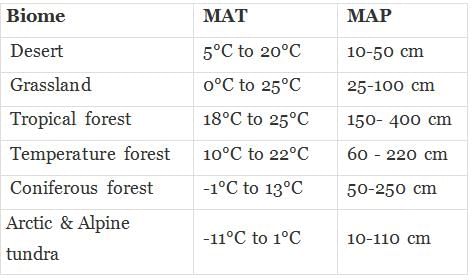NCERT Exemplar: Organisms & Populations - 1 | Biology Class 12 - NEET PDF Download
MULTIPLE CHOICE QUESTIONS
Q.1. Autecology is the:
(a) Relation of heterogeneous populations to its environment
(b) Relation of an individual to its environment
(c) Relation of a community to its environment
(d) Relation of a biome to its environment
Ans. (b)
Q.2. Ecotone is:
(a) A polluted area
(b) The bottom of a lake
(c) A zone of transition between two communities
(d) A zone of developing community
Ans. (c)
Q.3. Biosphere is:
(a) A component in the ecosystem
(b) Composed of the plants present in the soil
(c) Life in the outer space
(d) Composed of all living organisms present on earth which interact with the physical environment
Ans. (d)
Q.4. Ecological niche is:
(a) The surface area of the ocean
(b) An ecologically adapted zone
(c) The physical position and functional role of a species within the community
(d) Formed of all plants and animals living at the bottom of a lake
Ans. (c)
Q.5. According to Allen’s Rule, the mammals from colder climates have:
(a) Shorter ears and longer limbs
(b) Longer ears and shorter limbs
(c) Longer ears and longer limbs
(d) Shorter ears and shorter limbs
Ans. (d)
Q.6. Salt concentration (Salinity) of the sea measured in parts per thousand is:
(a) 10 - 15
(b) 30 - 70
(c) 0 - 5
(d) 30 - 35
Ans. (d)
Solution.
The salt concentrations is measured as salinity in parts per thousand, is less than 5 in inland waters, 30-35 in the sea and greater than 100 percent in some hypersaline lagoons.
Q.7. Formation of tropical forests needs mean annual temperature and mean annual precipitation as:
(a) 18 – 25°C and 150 – 400 cm
(b) 5 – 15°C and 50 – 100 cm
(c) 30 – 50°C and 100 – 150 cm
(d) 5 – 15°C and 100 – 200 cm
Ans. (a)
Solution.

Q.8. Which of the following forest plants controls the light conditions at the ground?
(a) Lianas and climbers
(b) Shrubs
(c) Tall trees
(d) Herbs
Ans. (c)
Solution.
Tall trees control the light conditions at the ground.
Q.9. What will happen to a well growing herbaceous plant in the forest if it is transplanted outside the forest in a park?
(a) It will grow normally
(b) It will grow well because it is planted in the same locality
(c) It may not survive because of change in its micro climate
(d) It grows very well because the plant gets more sunlight
Ans. (c)
Solution.
A well growing herbaceous plant in the forest if it is transplanted outside the forest in a park. It may not survive because of change in its micro climate.
Q.10. If a population of 50 Paramecium present in a pool increases to 150 after an hour, what would be the growth rate of population?
(a) 50 per hour
(b) 200 per hour
(c) 5 per hour
(d) 100 per hour
Ans. (d)
Solution.
Initial population of paramecium Pi = 50
After one hour population of paramecium Pf = 150
Growth rate after one hour = Pf – Pi
= 150 - 50 = 100
Q.11. What would be the per cent growth or birth rate per individual per hour for the same population mentioned in the previous question (Question 10)?
(a) 100
(b) 200
(c) 50
(d) 150
Ans. (b)
Solution.
The percent growth or birth rate per individual per hour =
= (final population - Initial population / Initial population) x 100
= (150 - 50 / 50) x 100
= 200
Q.12. A population has more young individuals compared to the older individuals. What would be the status of the population after some years?
(a) It will decline
(b) It will stabilise
(c) It will increase
(d) It will first decline and then stabilise
Ans. (c)
Q.13. What parameters are used for tiger census in our country’s national parks and sanctuaries?
(a) Pug marks only
(b) Pug marks and faecal pellets
(c) Faecal pellets only
(d) Actual head counts
Ans. (b)
Solution.
Sometimes population size is indirectly estimated without actually counting them or seeing them.
Example: The tiger census in our National Parks and Tiger Reserves is often based on pug marks and faceal pellets.
Q.14. Which of the following would necessarily decrease the density of a population in a given habitat?
(a) Natality > mortality
(b) Immigration > emigration
(c) Mortality and emigration
(d) Natality and immigration
Ans. (c)
Q.15. A protozoan reproduces by binary fission. What will be the number of protozoans in its population after six generations?
(a) 128
(b) 24
(c) 64
(d) 32
Ans. (c)
Solution.
Population after nth generations = 2n
Population after 6th generations = 26 = 64
Q.16. In 2005, for each of the 14 million people present in a country, 0.028 were born and 0.008 died during the year. Using exponential equation, the number of people present in 2015 is predicted as:
(a) 25 millions
(b) 17 millions
(c) 20 millions
(d) 18 millions
Ans. (b)
Solution.
dN/dt = rN
r = 0.028 - 0.008 = 0.02
dt = 2015 - 2005 = 10 years
N = N2005 = 14 million
dN = change in population in 10 years
dN/dt = 0.02 x 14 x 10
dN = 2.8 million
dN = N2015 - N2005
N2015 = dN + N2005
= 2.8 + 14
= 16.8 ≈ 17 million
Q.17. Amensalism is an association between two species where:
(a) One species is harmed and other is benefitted
(b) One species is harmed and other is unaffected
(c) One species is benefitted and other is unaffected
(d) Both the species are harmed.
Ans. (b)
Solution.

| + → Beneficial interaction - → Detrimental interaction 0 → Neutral interaction |
Q.18. Lichens are association of:
(a) Bacteria and fungus
(b) Alga and bacterium
(c) Fungus and alga
(d) Fungus and virus
Ans. (c)
Q.19. Which of the following is a partial root parasite?
(a) Sandal wood
(b) Mistletoe
(c) Orobanche
(d) Ganoderma
Ans. (a)
Q.20. Which one of the following organisms reproduces sexually only once in its life time?
(a) Banana
(b) Mango
(c) Tomato
(d) Eucalyptus
Ans. (a)
VERY SHORT ANSWER TYPE QUESTIONS
Q.1. Species that can tolerate narrow range of temperature are called ______.
Ans. Stenothermic
Q.2. What are Eurythermic species?
Ans. Species that tolerate wide range of temperature are called Eurythermic species.
Q.3. Species that can tolerate wide range of salinity are called ______.
Ans. Euryhaline
Q.4. Define stenohaline species.
Ans. Species that tolerate narrow range of salinity are called stenohaline species.
Q.5. What is the interaction between two species called?
Ans. Interspecific interaction
Q.6. What is commensalism?
Ans. Commensalism is the interaction in which one species benefits and the other is neither harmed nor benefited.
Q.7. Name the association in which one species produces poisonous substance or a change in environmental conditions that is harmful to another species.
Ans. Amensalism
Q.8. What is Mycorrhiza?
Ans. Mycorrhiza is a symbiotic association between a fungus and the roots of higher plants.
Q.9. Emergent land plants that can tolerate the salinities of the sea are called.
Ans. Mangroves
Q.10. Why do high altitude areas have brighter sunlight and lower temperatures as compared to the plains?
Ans. High altitude areas have brighter sunlight because at high altitude there is a very low concentration of dust particles and atmospheric gases which absorbs the sunlight. There is a low atmospheric pressure at high altitudes. Lower atmospheric pressure results in lower temperatures at high altitudes.
Q.11. What is homeostasis?
Ans. To maintain the constancy of internal environment despite varying external environmental conditions is called homeostasis.
Q.12. Define aestivation.
Ans. Aestivation is a state of dormancy characterized by inactivity and a lowered metabolic rate in response to high temperatures and arid conditions.
Q.13. What is diapause and its significance?
Ans. Under unfavorable conditions many zooplankton species in lakes and ponds are known to enter diapause, a stage of suspended development.
Q.14. What would be the growth rate pattern, when the resources are unlimited?
Ans. Exponential.
Q.15. What are the organisms that feed on plant sap and other plant parts called?
Ans. Phytophagous
Q.16. What is high altitude sickness? Write its symptoms.
Ans. If one had ever been to any high altitude place (>3,500m like Rohtang Pass near Manali and Mansarovar .in Tibetan Autonomous Region), the pathological effect caused by acute exposure to low partial pressure of oxygen at high altitude is called altitude sickness. Its symptoms include nausea, fatigue and heart palpitations.
Q.17. Give a suitable example for commensalism.
Ans. Cattle egret and grazing cattle.
Q.18. Define ectoparasite and endoparasite and give suitable examples.
Ans.
- Parasites that feed on the external surface of the host organism are called ectoparasites. The most familiar examples of this group are the lice on humans and ticks on dogs.
- Endoparasitesare those that live inside the host body at different sites (liver, kidney, lungs, red blood cells, etc.).'”The human liver fluke (a trematode parasite) is an endoparasite.
Q.19. What is brood parasitism? Explain with the help of an example.
Ans. Brood parasitism in birds is a fascinating example of parasitism in which the parasitic bird lays its eggs in the nest of its host and let the host incubate them. During the course of evolution, the eggs of the parasitic bird have evolved to resemble the host’s egg in size and colour to reduce the chances of the host bird detecting the foreign eggs and ejecting them from the nest.
|
78 videos|280 docs|174 tests
|
FAQs on NCERT Exemplar: Organisms & Populations - 1 - Biology Class 12 - NEET
| 1. What are some examples of organisms in an ecosystem? |  |
| 2. How do populations change over time? |  |
| 3. What is the difference between a population and a community? |  |
| 4. How does competition affect population dynamics? |  |
| 5. What are the factors that regulate population growth? |  |





















